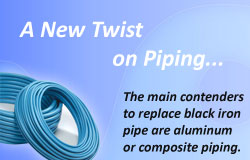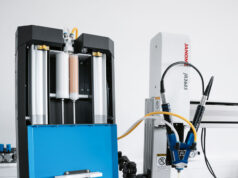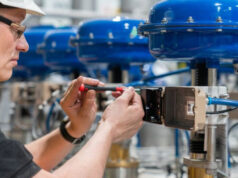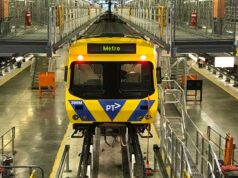The standard black iron pipe is no longer the standard. It stands to reason that as many new innovations are developed to overcome obstacles and issues that it is only a matter of time until plant piping systems evolved. Although black iron piping has been the norm for many years it has caused many head aches for plant maintenance personnel. From installation that requires pipe fitters and special machinery to build each section piece by piece the task is both time consuming and difficult. Once installed, it’s only a matter of time for the burrs and other contaminants to find there way into critical locations. This may be flaking particulate or cutting oils but whatever does make it down stream may cause some serious damage.
The main contenders to replace the black iron pipe are aluminum or composite piping.
|
|
|
 Each have there value based on installation, environment and personal preference. Some may prefer the aluminum as it’s an easier mental transition from black iron pipe but it too has limitations. Length of pipe and special machinery are still required to cut and smooth each piece to length and corrosion although minimal may still occur. Due to the limited lengths of the aluminum pipe it will be necessary to piece each length together with a fitting which not only requires additional time but also adds to an increasing leakage rate based on the size of the installation.
Each have there value based on installation, environment and personal preference. Some may prefer the aluminum as it’s an easier mental transition from black iron pipe but it too has limitations. Length of pipe and special machinery are still required to cut and smooth each piece to length and corrosion although minimal may still occur. Due to the limited lengths of the aluminum pipe it will be necessary to piece each length together with a fitting which not only requires additional time but also adds to an increasing leakage rate based on the size of the installation.
Composite piping systems have been used for some time but with pressure restrictions and safety code requirements hasn’t always been a viable choice. Until recent advances by which these materials have been re-engineered to meet such stringent safety codes as are required by ASME and OSHA these materials are slowly becoming the new standard. The composite piping systems are manufactured with two main materials, high impact ductile ABS (Acrylonitrile butadiene styrene) for larger diameters and HDPE (High-density polyethylene) for smaller diameters.
The latest, most interesting, product has been designed to have the HDPE encapsulate a flexible aluminum pipe essentially sandwiching the pipe between layers of composite HDPE. Commercially available from IPEX, the Duratec product line this product combines the best of all current options building on the flexibility and chemical prowess of HDPE with the strength of aluminum. Another distinct advantage this product has over aluminum, ABS or Black iron, for that matter, is the length of the material available. Coil lengths of 100 to 300 ft in length are available which not only decrease the time required to pipe a plant but also reduces leakage rates by not requiring an additional fitting every 8-12 feet.
When the final decision has to be made on what material will be used in a plant piping system the materials described above along with material cost and labour need to be considered. Some materials may work well and are relatively inexpensive but cost considerably more to install and maintain. Some average installation times are as follows:
Black Iron – 6ft/hr
Aluminum – 45ft/hour
High impact ductile ABS – 45ft/hour
Duratec HDPE – 100 ft/hour
The choice is definitely yours to make, each application is different and requires considerable planning and effort. But before a decision has been made consideration should be given to the latest materials and there capabilities. All decisions should be verified by a professional engineer to assure that all safety requirements have been considered.
Barry Chadwick, CET
©Pneumatics Online












